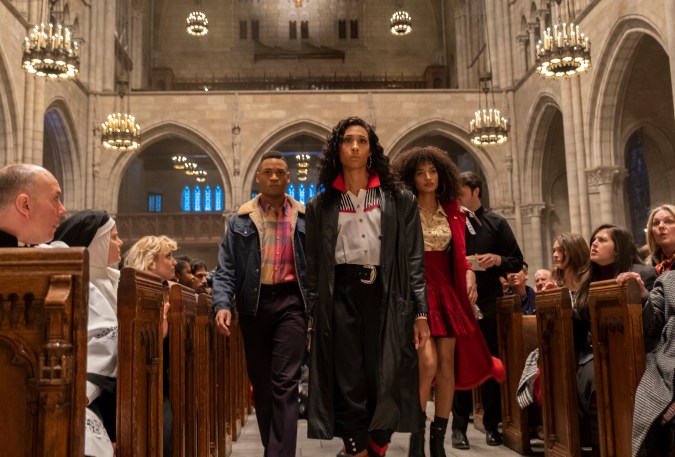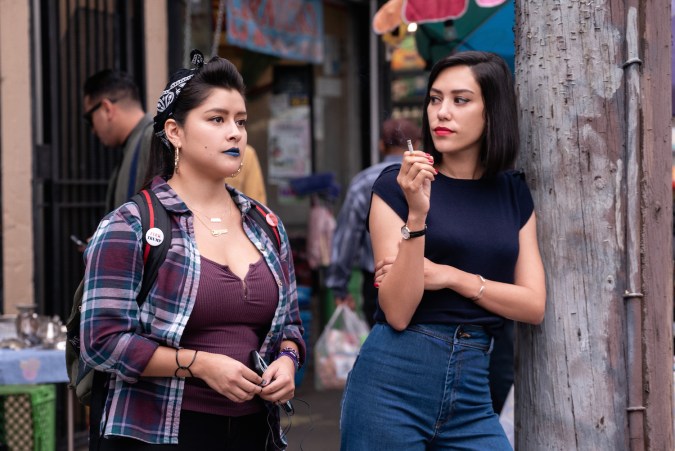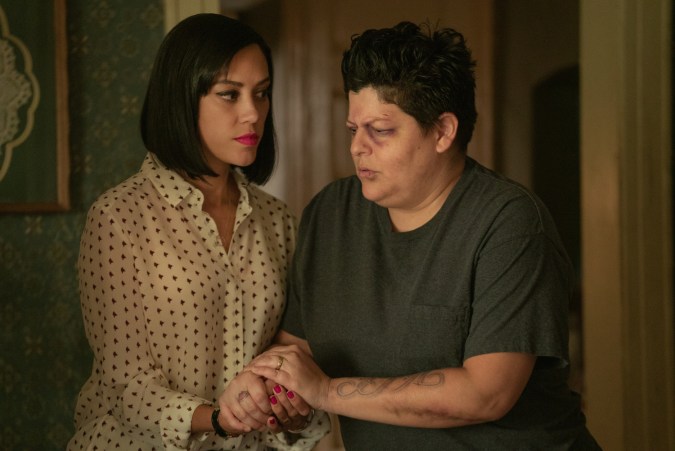LGBT folks make up roughly 40% of the homeless youth population, and a large percentage of this number is made up of Black and Latinx LGBT kids. While presenting this reality can be a burden for the few LGBT Latinx creators in mainstream television, Pose and Vida prove they are up to the task. Although their settings are separated by three decades, Pose and Vida create a direct timeline connected by the abusive dynamics that cause their respective conflicts. Each series’ approach is distinct, but they convey the harms of intracommunity homophobia and transphobia, as well as the multitudes of queer and trans Latinidad.
Pose, created by Steven Canals, is set in the ballroom scene of the late ‘80s and early ‘90s, a community that was historically made up of homeless or displaced LGBT Black, Afro-Latinx and non-Black Latinx folks. In episode five of season one, aptly titled “Mother’s Day,” the series’ protagonist, Blanca (MJ Rodriguez) commits to undoing familial trauma after attending her estranged mother’s funeral – the same mother who kicked her out of her home for being Transgender.
However, healing is not an easy task for Blanca, who is misgendered and gaslit by her sister for being absent during her mother’s illness. But Blanca holds her own by asserting: “How am I supposed to show up when you won’t even invite me in?”

Pose highlights how LGBT folks are often victim-blamed for keeping their distance from homophobic and transphobic families that refuse to change their harmful behavior. While Blanca almost loses hope after this encounter, her best friend, Pray Tell (Billy Porter), grounds her by stating, “You have us now. Your real family.”

With this reassurance, Blanca pushes through the catastrophic funeral and emerges with an understanding of the love required to establish healthy bonds between mother and child.
Pose presents chosen families as the remedy to the damage wrought upon by transphobia in Latinx families.
The resolution to Blanca’s arc in “Mother’s Day” is presented in a flashback that subtly flips audience expectations by shifting the lighting in the story’s present instead of its past. The flashback finds Blanca reconciling her feelings with her dead mother by remembering how they lovingly connected while cooking her favorite “fluffy and fruity pancakes.” Blanca’s memory is portrayed with the same warm lighting that fills her present home, the saturated yellows reminiscent of old Polaroids, connecting past and present mothers. After the retrospect ends, Blanca moves from the warm lighting that linked her home to her flashback to cool blue lighting as she walks to cook with her chosen son, Damon (Ryan Jamaal Swain). The movement from warm to cool lighting, past to present, marks Blanca’s internal change: She makes the active decision to end the cycles of trauma by passing on only her mother’s good lessons to her own children. The scene cements this metamorphosis when Blanca reiterates her mother’s words to Damon, “I will love you forever.” Thusly, Pose presents chosen families as the remedy to the damage wrought upon by transphobia in Latinx families.

While Vida shares thematic similarities with Pose, prioritizing chosen families as a way to heal familial trauma is not one of them. Vida, created by Tanya Saracho, takes place in modern-day Boyle Heights and dives into the whirlwind family dynamics of two sisters, Lynn (Melissa Barrera) and Emma (Mishel Prada), as they attempt to rebuild their relationship and family business while wrestling with their role as gentrifiers. Although gentrification is the prominent conflict in Vida, the series uses Emma’s storyline to explore displacement on a micro-level.

The weight of this generational pain initially seems insurmountable, but Vida offers the protagonists vehicles for healing.
While she’s not homeless, Emma experiences displacement by being uprooted repeatedly from her Boyle Heights community because of her mother’s discomfort with Emma’s queerness. In episode four of season one, “A Night Out,” the series employs its soundtrack and camera angles to heighten the impact of Emma’s first moment of public vulnerability. During a night of bar-hopping with her new queer friends, Emma is confronted by her longtime crush, Cruz (Maria-Elena Laas), who believes Emma stayed away from her hometown because she hated it. But Emma dispels this by recalling how her mother, Vidalia, sent her away twice: first at 11 when she caught Emma being physical with another girl, then as a teenager when she found Emma’s journal entries that disclosed her love for Cruz. During this revelation, The Caifanes’ cover of “La Negra Tomasa” complements the scene’s emotional weight by softly playing in the background. Sadly, the lyrics are not about the love of two star-crossed baby queers, but they nonetheless convey the pain of losing a lover after they leave their home: “Estoy tan enamorada de la negra Tomasa / Que cuando se va de casa triste me pongo.”
Adding to the intensity of Emma’s vulnerability is the camera angle used in the scene. First, it establishes a spinning long shot that tracks Emma’s inebriation and foreshadows her eventual disturbance; then, by closing in on her face to capture her inner journey, from jovial drunk to vindicated confessor. Finally, the camera pans away as Emma rejoins her friends and deceivingly puts the issue at bay, only for it to close in again and hover over her as her trauma manifests as an anxiety attack.

The weight of this generational pain initially seems insurmountable, but Vida offers the protagonists vehicles for healing: reconnection to ancestors, immediate family and home. Notably, Emma and Lynn’s dedication to saving their family bar serves as a metaphor for the protagonists’ need to rebuild their lives after familial trauma has taken all it could. On a literal level, the sisters rename the bar Vida to honor their mother, but figuratively, the new name represents their new beginnings.

Though Vida and Pose are currently two of the only shows portraying the violence endured by LGBT Latinxs, they are part of a broadcast legacy that can be traced back to 1994. As the patron saint of homeless LGBT Latinxs on primetime, My So-Called Life’s Rickie Vasquez was among the first to bring the issue to American television. While these storylines would otherwise read as tired tropes, the sobering reality of LGBT Latinx displacement transforms them into cultural reflections. They demand that Latinx families confront their LGBT-antagonism and make these narratives into relics, not mirrors projecting uncomfortable truths through our screens.




